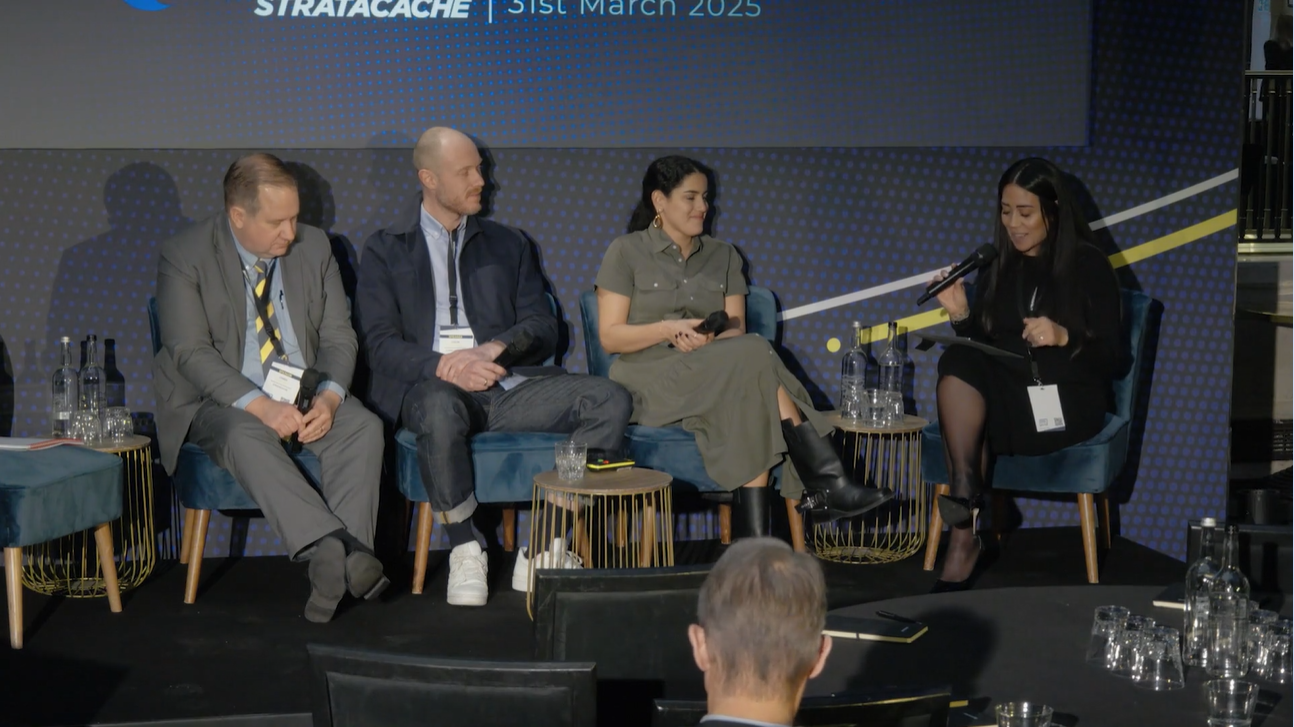




At the What’s In Store for Retail Media Networks event in London, one of the final masterclasses brought together some of the industry’s leading voices to address a topic that continues to blur the boundaries and cause great debate: What’s the real difference between in-store retail media and digital out-of-home (DOOH)? The discussion featured Chris Riegel, CEO and founder of STRATACACHE; Yara El Saadani, EMEA Commerce Strategy Director at GroupM; and Colin Horan, Strategic Partner, FMCG at Clear Channel — each offering a distinct perspective shaped by their experience in commerce, media strategy, and technology innovation.
The session kicked off with a straightforward question: How do you define in-store media vs. DOOH? While the IAB’s simple geography-based definition (inside the store vs. outside) serves as a starting point, it quickly became clear that the conversation is more nuanced. Horan noted that Clear Channel, traditionally focused on DOOH formats like roadside and high street screens, now also works on digital screens located within retail environments, such as Sainsbury’s and Asda. This overlap, he explained, has made the distinction between channels more complex — but also more powerful.
Chris Riegel offered a hard line: in-store retail media is not DOOH. “If you call in-store ‘out-of-home,’ you’re short-selling your network,” he stated. For Riegel, the distinction isn’t just physical — it’s operational. In-store media offers a depth of first-party data, a proximity to point-of-purchase, and a path to attribution that DOOH simply cannot replicate. It’s a unique media category in its own right, with significantly higher potential value.
That value, all three panelists agreed, lies in the data. El Saadani stressed that retail media, whether in-store or DOOH, is ultimately about layering on first-party data to deliver measurable impact. “The beauty of retail media is that it uses commerce data to power both channels,” she said. Whether you’re targeting screens at the store entrance or deeper into the aisles, access to shopper data transforms those screens into actionable touchpoints.
From the STRATACACHE perspective, the future of in-store retail media is one of hyper-targeted, data-informed messaging. Riegel emphasized how deep behavioral analytics — tracking not just purchases, but also time spent browsing, near-miss conversions, and shelf interactions — can build precise customer profiles. This level of granularity opens the door to custom, one-to-one messaging that’s impossible in a traditional DOOH model.
But how are brands using these channels today? According to the panel, adoption is uneven. El Saadani observed that many brands are still grappling with the internal split between trade and media budgets. As brands move more investment to the marketing side, they gain greater access to nuanced data and the ability to negotiate more tailored campaigns.
Horan added that agencies and brands alike often misinterpret the reach potential of DOOH. “Brands still think in terms of proximity buying — targeting screens within 500 meters of stores,” he explained. But mobility patterns, especially in a hybrid work world, suggest that people shop and move far differently than assumed. Using DOOH data to better model shopper journeys could unlock significant campaign value.
One striking insight from the session? While data, targeting, and measurement dominate the conversation around retail media, creativity is at risk of being sidelined. “Everyone’s talking about data, measurement, personalization,” Horan said, “but no one’s talking about creativity.” Without emotional connection and compelling storytelling, even the most precisely targeted campaigns can fall flat. All panelists agreed: future success in both in-store and DOOH will require a return to creative excellence.
When asked about the future, the panel offered a bold vision. Riegel predicted a world where in-store shoppers will self-identify via mobile apps and loyalty programs, opting into fully personalized experiences based on variables such as their preferences, dietary needs, and values. This “Minority Report-style” journey, he said, will be welcomed by shoppers who see it as helpful rather than invasive.
El Saadani and Horan echoed this sentiment, calling for more innovation in formats beyond digital screens, deeper commerce integration, and more collaborative agency-brand-retailer relationships. Ultimately, the path forward lies in connecting the dots between environments — blending the emotional resonance of DOOH with the targeting power of in-store media.
As retailers, brands, and media owners all vie for attention in a crowded landscape, understanding the difference between in-store retail media and DOOH isn’t just academic — it’s strategic. This session made one thing clear: in a world where personalization, performance, and storytelling all matter, successful campaigns won’t choose between channels — they’ll use both, better.
Unlock the insights—watch the full masterclass here.
Explore every session from London’s What’s In Store for Retail Media Networks event here.